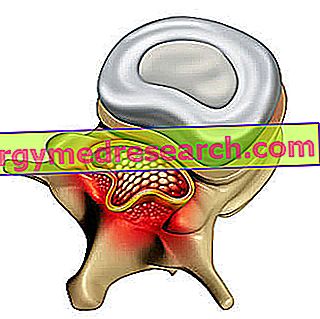Generality
Faringodinia is the medical term that indicates the painful condition known to most people as sore throat or pain in the pharynx.

Pharyngodynia is the most characteristic symptom of pharyngitis, namely inflammation and irritation of the pharynx. The phenomenon of pharyngitis can be caused by numerous conditions, including: some viral infections, some bacterial infections, some allergic forms, gastroesophageal reflux disease, chronic tonsillitis, chronic sinusitis, cancer of the throat or mouth, the excessive use of the voice, etc.
Pharyngodynia is often associated with several other ailments, such as, for example, hoarseness, weak voice, rhinorrhea, sneezing, fever, nasal congestion, painful swallowing, dry throat, malaise and respiratory problems.
During the diagnosis of pharyngodynia, it is very important to establish the triggering causes, because the knowledge of the latter depends on the most appropriate treatment planning, as well as the possibility of achieving recovery.
Brief anatomical and functional recall of the pharynx
The pharynx is the musculo-membranous duct located at the back of the mouth, identifiable with the anatomical part that commonly takes the name of throat .
Approximately 13 centimeters long and covered by a layer of mucosa, the pharynx is confined on the upper part to the nasal cavity and inferiorly to the larynx and esophagus.
In the pharynx, the anatomists recognize three main components: the nasopharynx (or nasopharynx ), the oropharynx and the hypopharynx (or laryngopharynx ).
The nasopharynx is the upper part of the pharynx, placed in direct contact with the choanae; the oropharynx is the intermediate portion of the pharynx, located between the nasopharynx and epiglottis (upper end of the larynx); finally, the hypopharynx is the lower portion of the pharynx, below which the esophagus begins.
From the functional point of view, the pharynx has the important task of directing the food towards the esophagus, consequently avoiding the path of the trachea (which serves for breathing).
Being covered by food and in large part also from the air, the pharynx constitutes, together with the mouth, one of the two fundamental features of the so-called upper digestive airways .
What is pharyngodynia?
" Faringodinia " is the medical voice that literally means pain in the pharynx, while, with a more slang meaning, it means pain in the throat or sore throat .

Origin of the name
The term faringodinia is the result of the union between the words "faringo-" and "-odinia":
- "Faringo" is the word that, as it is easy to understand, refers to the pharynx.
- "Odinia", on the other hand, is the word that indicates the presence of pain. Odinia is the Italian derivation of the Greek word " odyne " ( οδυνη ), which means "pain".
Causes
Pharyngodynia is the most characteristic symptom of inflammatory and irritative processes that can affect the pharynx. Inflammation and irritation of the pharynx is the medical condition known as pharyngitis .
Pharyngodynia, therefore, is the manifestation par excellence of pharyngitis.
Causes of pharyngitis
The causes of pharyngitis are numerous; among these are:
- Viral infections (eg: cold virus, measles virus, varicella virus, mononucleosis virus, influenza virus, HIV, etc.);
- Bacterial infections (eg: Streptococcus beta hemolytic group A, Streptococcus pneumoniae, Haemophilus influenzae, Bordetella pertussis, Bacillus anthracis, Corynebacterium diphtheriae, Neisseria gonorrhoeae, Chlamydophila pneumoniae and Mycoplasma pneumoniae );
- Allergic reactions to mold, animal hair, pollen or dust;
- Gastroesophageal reflux disease;
- Malignant tumors at the level of the pharyngo-laryngeal tract or at the level of the oral cavity (throat cancer, laryngeal tumor and tongue tumor);
- Chronic tonsillitis (chronic inflammation of the palatine tonsils);
- Chronic sinusitis (chronic inflammation of the paranasal sinuses);
- Untreated dental abscesses;
- Chronic inhalation of irritating substances (polluted air, cigarette smoke, toxic fumes, etc.);
- The protracted and excessive effort of the pharynx muscles (it happens, for example, to those who talk a lot and those who sing by profession);
- Excessive dryness in the home or work environment, due to incorrect use of heating systems;
- Breathing through the mouth, imposed by conditions that are an obstacle to nasal breathing, such as turbinate hypertrophy, nasal polyps and chronic rhinitis.
- Hypertrophy of the turbinates : it is the nasal suffering which consists in chronic and permanent swelling of the respiratory ciliate mucosa of the turbinates (small bony protrusions of the nasal septum covered by particular tissues).
- Nasal polyp: probably the result of inflammatory processes, nasal polyps are soft benign, multiple or solitary tumor growths, which grow on the nasal mucosa or inside the paranasal sinuses.
- Chronic rhinitis : it is an irritative and inflammatory process on the nasal mucosa, whose symptoms appear gradually, last several months and are of moderate severity.
Risk factors
The risk factors of pharyngodynia are the same risk factors as pharyngitis; so I am:
- Young age. Children and adolescents can suffer from pharyngodynia even more than once in the same year;
- Cigarette smoke and passive smoking;
- Presence of an allergy to dust, pollen, animal hair or mold;
- Presence of chronic sinusitis;
- Work activities involving exposure to chemical irritants, toxic dust, etc .;
- Attendance of crowded places (eg: schools, kindergartens, barracks, prisons), where it is easy to transmit the most common infectious diseases (eg: cold);
- Presence of immunodepression.
Symptoms and Complications
Pharyngodynia can be the result of acute pharyngitis or chronic pharyngitis .
In the first case (acute pharyngitis), the sore throat is intense, with rapid appearance and short duration; in the second case (chronic pharyngitis), instead, the pain in the pharynx is of slight intensity (in any case lesser than in the previous situation), with a gradual and persistent appearance over time.
Characteristics of the painful sensation
In pharyngodynia, throat pain can be burning or itchy (ie associated with itching).
The characteristics of pharyngodynia depend on the triggering causes; for example, while pharyngitis due to allergic reactions is typically responsible for pharyngodynia, the inflammation of the pharynx by viral infection triggers, as a rule, a pharyngodinia of a burning type.
Associated symptoms
Pharyngodynia is usually associated with other symptoms and some particular signs; these include:
- Hoarseness and weak voice;
- Sensation of a foreign body or a lump in the throat;
- Need to constantly have to free the throat;
- Pain during swallowing or while talking;
- Sense of general malaise and tiredness;
- Respiratory problems;
- Dry throat;
- Sneezing;
- Nasal congestion (stuffy nose) and rhinorrhea (runny nose);
- Hypertrophy of the pharyngeal mucosa;
- Hypertrophy of the seromucinose glands of the throat;
- Presence of reddish nodules on the posterior pharyngeal wall;
- Increased mucus secretion;
- Enlarged and inflamed lymph nodes of the neck and jaw;
- Swollen and reddened tonsils;
- Presence, on the tonsils, of white or pus plates;
- Elongated and hypertrophic uvula;
- Skin eruptions.
The precise symptomatology associated with pharyngodynia varies in relation to the triggering factor; for example, pharyngodynia of viral origin is generally combined with fever, a sense of general malaise, tiredness and sometimes sneezing; while the pharyngodynia of allergic origin typically combines with rhinorrhea, repeated sneezing and rash (note the absence of fever).
Diagnosis
Diagnosing pharyngodynia is simple and requires only physical examination ; discovering its triggers, on the other hand, is slightly more complex - especially in some circumstances - and may require different investigations, both laboratory and instrumental.
Identification of the causes of pharyngodynia
The identification of the causes of pharyngodynia always starts from the anamnesis (or clinical history ). In the most banal situations, the latter may be sufficient for the purpose; in the most complex circumstances, on the other hand, it may represent the first stage of a diagnostic procedure which is followed by:
- A pharyngeal swab;
- A blood test;
- Otorhinolaryngology tests;
- Allergic tests;
- An endoscopic examination of the throat and larynx;
- A nuclear magnetic resonance or a CT scan referred to the pharyngeal area.
Why is it important to find out the causes?
The knowledge of the causes of pharyngodynia is very important, because the most adequate therapy planning and the achievement of recovery depend on the causative factors.
Without knowing what caused pharyngodynia and related pharyngitis, there is little hope of establishing the most appropriate treatment.
Care and Treatment
The treatment of pharyngodynia involves, first of all, a therapy aimed at treating the cause of pharyngitis ( causal therapy ) and, secondly, a therapy aimed at alleviating pain and symptoms associated with pain ( symptomatic therapy ).
Causal therapy
Causal therapy is essential for achieving healing; moreover, taking up a concept expressed in part previously, it is unthinkable to heal from a disorder, an illness, etc. without treating the causes.
As can be easily understood, the causal therapy of pharyngodynia varies in relation to the factor that has caused and continues to cause inflammation of the pharynx. For example, this means that:
- The causal therapy of a pharyngodynia due to gastroesophageal reflux disease consists of all those remedies and treatments (pharmacological, for less severe cases, and surgical, for the most serious cases) aimed at minimizing the number of daily episodes of ascent towards esophagus of gastric contents;
- The causal therapy of a pharyngodynia of bacterial origin involves the administration of antibiotics;
- The causal therapy of a pharyngodinia due to cigarette smoking is to stop smoking;
- The causal therapy of a pharyngodynia of viral origin is based on rest from any tiring activity, up to, at least, at the end of the febrile state;
- The causal therapy of a pharyngodynia due to a throat tumor involves the removal of the tumor mass by radiotherapy, chemotherapy and / or surgery.
From the examples given above, it appears clear that, depending on the circumstances, causal therapy can be a treatment without invasiveness and risks, or an invasive treatment and at risk of complications.
Symptomatic therapy
Symptomatic therapy is essential to reduce the patient's suffering, in the period in which the patient is undergoing causal therapy.
To appease pharyngodynia and associated symptoms, the following are essential:
- The rest of the voice;
- Gargle with solutions based on heated water and salt;
- The intake of anti-inflammatory and pain-relieving drugs (eg: paracetamol, ibuprofen and aspirin);
- Do not smoke (if the patient is a smoker) and do not frequent smokers;
- Do not visit dry or dusty areas.
Prevention
Pharyngodynia is the consequence of largely preventable conditions.
In the following, the article reports a series of prevention rules against pharyngitis, clearly valid to prevent even pharyngodynia.
How to prevent pharyngitis (and pharyngodynia)
- Caring for personal hygiene and periodically sanitize the environment in which one habitually lives;
- Wash your hands with soap and water;
- Periodically clean items such as the phone, computer keyboard, door handles, etc. These precautions protect against infective pharyngitis;
- Avoid direct contact with people suffering from a viral or bacterial disease;
- Not smoking;
- Avoid exposure to passive smoking;
- Use the right protections (eg: masks) against the inhalation of certain toxic chemical substances, dust, etc .;
- Humidify living rooms that are too dry;
- Adopt a diet that preserves an important problem like gastroesophageal reflux disease.
Prognosis
The prognosis in case of pharyngodynia depends on at least two factors, which are:
- The triggering cause. In the presence of pharyngodynia, the chances of a benign prognosis are greater when the triggering factor of pharyngitis is of slight clinical relevance (ie it is not severe);
- The timeliness of the diagnosis and treatment of the triggering cause. Especially in certain situations (eg tumors or gastroesophageal reflux disease), early diagnosis and treatment of the cause of pharyngodynia allow us to hope for a better prognosis.



